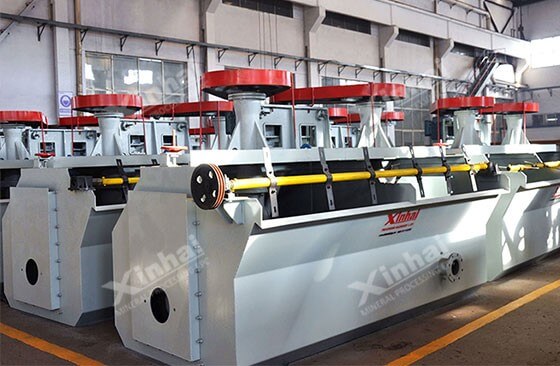

Warm Tip: If you want to know more details about equipment, solutions, etc, please click the button below for free consultation, or leave your requirements!
For different types of lithium ore, mineral processing methods are also different. It is the right place to know how to extract lithium from its ore here. Let's drive in now.

This article will start from salt lake brine lithium ore and lithium pyroxene ore, with you to understand the common lithium ore processing methods.
In such deposits, lithium is dissolved in saline groundwater, mainly in the form of inter-crystal brine, void brine and surface brine, etc.
The methods for extracting lithium from the brine of the lake containing lithium mainly include precipitation method, calcining leaching method, carbonization method, ion exchange adsorption method and so on.
The principle of precipitation method is that according to the composition characteristics of brine in salt lakes, the solubility of different minerals is different, and the minerals are extracted successively according to the order of boron, magnesium and lithium.
This method can be further divided into carbonate precipitation method, aluminate precipitation method, boric magnesium and boron lithium co-precipitation method, among which the carbonate precipitation method is of industrial value.
The process of obtaining lithium carbonate by this method does not need high temperature and high pressure, nor does it have waste gas emission, which is a relatively simple method with little energy consumption and pollution.
This method is used to treat the mixture obtained by evaporation of brine after boron is extracted.
After adding lime milk to remove sulfate, chloromagite and other steps, the concentrated lithium-rich liquid is calcined, extracted, precipitated, solid-liquid separated and dried to obtain lithium carbonate solid.
This process has certain requirements on the composition of raw ore, which is more suitable for carbonate-type salt lakes with a lower proportion of magnesium and lithium.
The principle is that lithium carbonate reacts with carbon dioxide and water to form lithium bicarbonate with higher solubility, so as to separate from other minerals.
In industrial production, the process used generally has the following steps: scrubbing, separation, water immersion, carbonization, pyrolysis.
It's also a simpler process.
In addition to the above three methods, other methods used to extract lithium from salt lake brines have not been used in industrial production, so they will not be described in this paper.
Pyroxene mainly produces pegmatite of white mica type and limonite type, which is often associated with minerals such as limonite, beryl, columbite-tantalite and tourmaline.
This kind of mineral usually contains a lot of clay minerals, which are easy to be muddy in the grinding stage, so the grinding fineness should be strictly controlled.
Common mineral processing methods for pyroxene are hand separation, flotation, heavy liquid separation, magnetic separation and so on.
Flotation is a commonly used method for the separation of pyroxene, and the important aspects in the flotation process are the mixing strength, temperature and the ratio of adjusting agent.
Commonly used system of spodumene flotation reagents are usually two soap "three bases", the "three bases" refers to the sodium carbonate, sodium sulfide and sodium hydroxide, "two soap" refers to the naphthenic acid soap and oxidized paraffin soap, add the "three bases" to keep slurry pH value in the range of 4.0 ~ 9.0, and reduce the effects of calcium on flotation, the use of "two soap" can be easily pure mineral spodumene flotation out surface.
Of course, in the process of flotation, the flotation index is greatly affected by the factors of water quality and environment.
Because of its relatively high density, pyroxene can be selected as a heavy mineral. Therefore, it is usually selected to modate heavy suspension with tribromomethane, tetrabromoethane and other media. Because tribromomethane and tetrabromoethane are volatile and stimulate human mucous membrane and auditory organs, heavy liquid separation method is seldom used in industrial production.
Because the lithium pyroxene mineral often contains a small amount of iron impurities, so the magnetic separation method can be used to separate the iron impurities in the lithium pyroxene concentrate or the lithium pyroxene mica.
In addition to the above single mineral processing method, due to the complex association of pyroxene with other minerals, the combined mineral processing method is usually adopted for the treatment of pyroxene minerals, such as "gravity separation-magnetic separation-flotation".
Gravity separation is used to select niobate tantalite and cassiterite, magnetic separation is used to separate niobate tantalite crude concentrate, and flotation is used to select pyroxene.
Compared with single mineral processing method, combined mineral processing method can get more effective comprehensive recovery of resources.
The above are some common lithium mineral separation methods. For the production of concentrator, it is very important to know the composition and properties of minerals. On this basis, it is relatively scientific and reasonable to use mineral processing test as the process flow, which can effectively reduce investment loss.
If you have lithium ore for beneficiation, we can provide you with process design and equipment. Welcome to leave a message on our website, or consult online customer service for details.
Last: What Are the Common Nickel Mineral Processing Technologies?
Next: What Is The Role of Desorption Electrolysis System in The Leaching of Gold?
1How to Extract Nickel From Copper-Nickel Sulfide Ore?
 1
1
 4206
4206
2What Are the Common Nickel Mineral Processing Technologies?
 3
3
 4379
4379
3How to Process Kaolin?
 0
0
 3519
3519


What Are the Differences Between CIP and CIL?
 11294
11294
 0
0